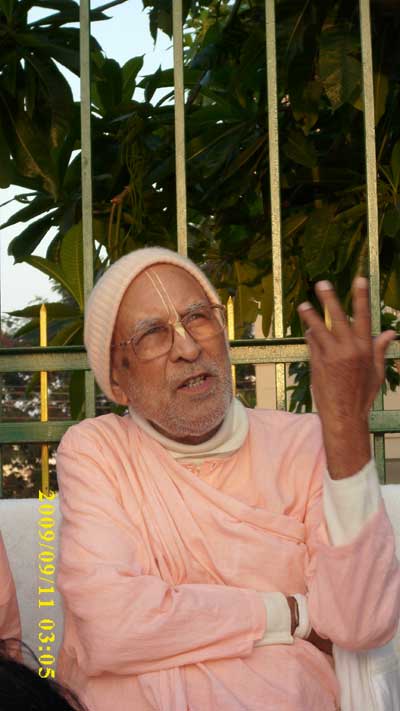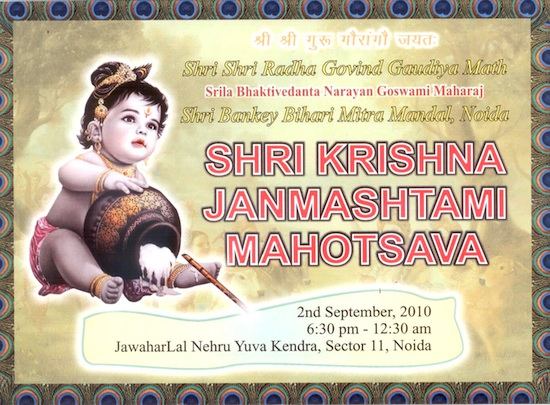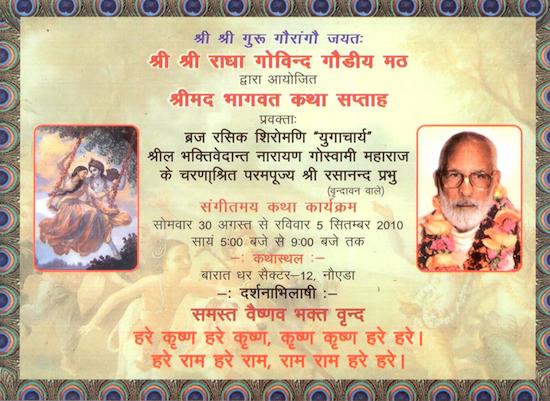Sri Krishna Janmastami
Pesquisar este blog
Translate

terça-feira, 7 de agosto de 2012
Janmastami Glorification Of Sri Radha
Janmastami Glorification Of Sri Radha
Mathura, India
20th August 2003
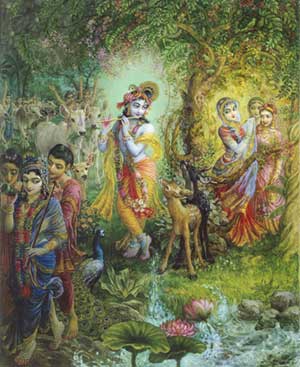 [Respected Harikatha Readers,
[Respected Harikatha Readers,samarpayitum unnatojjvala-rasam sva-bhakti-sriyam
harih purata-sundara-dyuti-kadamba-sandipitah
sada hrdaya-kandare sphuratu vah saci-nandanah
(Sri Caitanya-caritamrta Adi-lila, 1.4)
sucarcitanga-candanam namami nandanam (1)
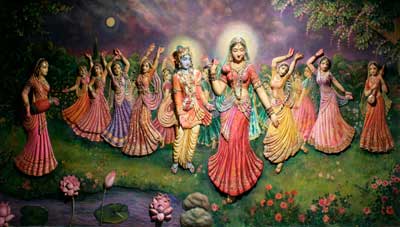 Why did Lord Krsna manifest His rasa-lila? Ordinary devotees cannot understand it, what to speak of those who are fallen and engaged in sinful activities. Srila Rupa Gosvami explained that Krsna is very merciful; if He had not brought rasa-lila from Goloka Vrndavana to this world, nobody would have the opportunity to understand it. By hearing about rasa-lila from pure devotees, one develops lobha (transcendental greed) to obtain that very confidential and difficult to obtain parakiya-rasa, unnatojjvala-bhava (paramour love for Krsna). Krsna performed rasa-lila to awaken greed in the hearts of those who are not qualified, to make them qualified to taste rasa. And, by the same exhibition of rasa-lila, He also increases these mellows tasted by those who are already tasting rasa. He is therefore very merciful, and Srimati Radhika is even more merciful than He.
Why did Lord Krsna manifest His rasa-lila? Ordinary devotees cannot understand it, what to speak of those who are fallen and engaged in sinful activities. Srila Rupa Gosvami explained that Krsna is very merciful; if He had not brought rasa-lila from Goloka Vrndavana to this world, nobody would have the opportunity to understand it. By hearing about rasa-lila from pure devotees, one develops lobha (transcendental greed) to obtain that very confidential and difficult to obtain parakiya-rasa, unnatojjvala-bhava (paramour love for Krsna). Krsna performed rasa-lila to awaken greed in the hearts of those who are not qualified, to make them qualified to taste rasa. And, by the same exhibition of rasa-lila, He also increases these mellows tasted by those who are already tasting rasa. He is therefore very merciful, and Srimati Radhika is even more merciful than He.prasara-krta-kataksa-prapti-kamah prakaman
anusarati yad uccaih snana-sevanu-bandhais
tad ati-surabhi radha-kundam evasrayo me
sraddhanvito 'nusrnuyad atha varnayed yah
bhaktim param bhagavati pratilabhya kamam
hrd-rogam asv apahinoty acirena dhirah
(Srimad-Bhagavatam,10.33.39)
sexta-feira, 19 de agosto de 2011
Janmashtami 2010 with Srila Gurudeva in Delhi Math
DOMINGO, 5 DE SETEMBRO DE 2010



















http://backtobhakti.com/2010/09/janmashtami-2010-with-srila-gurudeva-in-delhi-math/

 |
sábado, 28 de agosto de 2010
Sri Sri Guru Gaurangau Jayatah!!!!
| Hari Katha, Janmastami - Nodia, UP, India: 30th August - 5th September 2010 | | | |
| Wednesday, 25 August 2010 http://www.purebhakti.com/events/upcoming-events-mainmenu-66/1166-hari-katha-janmastami-nodia-up-india-30th-august-5th-september-2010.html |
|
Sri Sri Guru Gaurangau Jayatah By the causeless mercy of Srila Gurudev, Sri Sri Radha Govind Gaudiya Matha, Noida (India) is organising Srimad Bhagawat Katha by Sripad Rasanand Prabhu as per following program (at two locations): Date: 30th August to 5th September 2010 At a separate location, a grand celebration of Sri Krishna Janmashtami is being organised. Every year this festival is attended by more than 30000 people. Date: 2nd Septemper 2010 at Aspiring to serve Hari, Guru and Vaishnavas Anirudh Das Sri Radha Govind Gaudiya Math
Jaya Srila Gurudeva ! |
sexta-feira, 27 de agosto de 2010
THE 108 NAMES OF LORD SRI KRISHNA

1. om sri-krsnaya namah
2. om kamala-nathaya namah
3. om vasudevaya namah
4. om sanatanaya namah
5. om vasudevatmajaya namah
6. om punyaya namah
7. om lila-manusa-vigrahaya namah
8. om srivatsa-kaustubha-dharaya namah
9. om yasoda-vatsalaya namah
10. om haraye namah
11. om caturbhujatta-cakrasi-gada-sankhambujayudhaya namah
12. om devaki-nandanaya namah
13. om srisaya namah
14. om nanda-gopa-priyatmajaya namah
15. om yamuna-vega-samharine namah
16. om balabhadra-priyanujaya namah
17. om putana-jivita-haraya namah
18. om sakatasura-bhanjanaya namah
19. om nanda-vraja-jananandine namah
20. om sac-cid-ananda-vigrahaya namah
21. om navanita-viliptangaya namah
22. om navanita-nataya namah
23. om anaghaya namah
24. om navanita-navaharaya namah
25. om mucukunda-prasadakaya namah
26. om sodasa-stri-sahasresaya namah
27. om tribhangi-madhurakrtaye namah
28. om suka-vag-amrtabdhindave namah
29. om govindaya namah
30. om yoginam pataye namah
31. om vatsa-palana-sancarine namah
32. om anantaya namah
33. om dhenukasura-mardanaya namah
34. om trni-krta-trnavartaya namah
35. om yamalarjuna-bhajanaya namah
36. om uttala-tala-bhetre namah
37. om tamala-syamalakrtaye namah
38. om gopa-gopisvaraya namah
39. om yogine namah
40. om koti-surya-sama-prabhaya namah
41. om ilapataye namah
42. om parasmai jyotise namah
43. om yadavendraya namah
44. om yadu-dvahaya namah
45. om vanamaline namah
46. om pita-vasase namah
47. om parijatapaharakaya namah
48. om govardhanacaloddhartre namah
49. om gopalaya namah
50. om sarva-palakaya namah
51. om ajaya namah
52. om niranjanaya namah
53. om kama-janakaya namah
54. om kanja-locanaya namah
55. om madhughne namah
56. om mathura-nathaya namah
57. om dvaraka-nayakaya namah
58. om baline namah
59. om vrndavananta-sancarine namah
60. om tulasi-dama-bhusanaya namah
61. om syamantaka-maner hartre namah
62. om nara-narayanatmakaya namah
63. om kubjakrstambara-dharaya namah
64. om mayine namah
65. om parama-purusaya namah
66. om mustikasura-canura-malla-yuddha-visaradaya namah
67. om samsara-vairine namah
68. om kamsaraye namah
69. om muraraye namah
70. om narakantakaya namah
71. om anadi-brahmacarine namah
72. om krsnavyasana-karsakaya namah
73. om sisupala-siras-chetre namah
74. om duryodhana-kulantakaya namah
75. om vidurakrura-varadaya namah
76. om visvarupa-pradarsakaya namah
77. om satya-vace namah
78. om satya-sankalpaya namah
79. om satyabhama-rataya namah
80. om jayine namah
81. om subhadra-purvajaya namah
82. om visnave namah
83. om bhisma-mukti-pradayakaya namah
84. om jagad-gurave namah
85. om jagannathaya namah
86. om venu-nada-saradaya namah
87. om vrsabhasura-vidhvamsine namah
88. om banasura-karantakaya namah
89. om yudhisthira-pratisthatre namah
90. om barhi-varhavatamsakaya namah
91. om parthasarathaye namah
92. om avyaktaya namah
93. om gitamrta-mahodadhaye namah
94. om kaliya-phani-manikya-ranjita-sri-padambujaya namah
95. om damodaraya namah
96. om yajna-bhoktre namah
97. om danavendra-vinasakaya namah
98. om narayanaya namah
99. om para-brahmane namah
100. om pannagasana-vahanaya namah
101. om jala-kridasamasakta-gopi-vastrapaharakaya namah
102. om punya-slokaya namah
103. om tirtha-karaya namah
104. om veda-vedyaya namah
105. om daya-nidhaye namah
106. om sarva-bhutatmakaya namah
107. om sarva-graha-rupine namah
108. om parat-paraya namah
Sri Krishna-Janma-Tithi Vidhi by Srila RUpa Gosvami
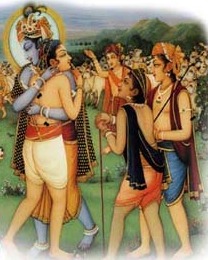
Sri Krishna-Janma-Tithi Vidhi by Srila RUpa Gosvami
THIS IS A simplified version of Srila RUpa Gosvami’s description of how to perform
abhisheka to the Lord on Krishna-Janmasthami. The main simplification is the exclusion of the
extensive Vedic mantras which accompany the offering of most of the items. Since to
properly chant these mantras requires extensive training and practice, and since
nAma-sankirtana is most pleasing to the Lord and most appropriate for this age, it is most
appropriate to accompany abhisheka with melodious kirtana. We have not excluded any items
to be offered; however, considering time and means available it is possible to make
adjustments, reducing the number of items offered either slightly or extensively, but keeping
the same order of offering given here. This general procedure can be used in the abhisheka of
other Deities than Krishna on appropriate days, with appropriate adjustments — Radha on
Radhastami, Gauranga on Gaura-purnima, etc.
Preliminary Activities
1.Prepare a snana-vedi (pedestal for bathing the Deity), situated within a well decorated mandapa (ideally, a
four-pillared canopied temporary pavillion fenced off by red string).
2.Perform all the pUrvanga-karmas for self-purification: snana, bhuta-suddhi, nyasa, etc.
3.Bring the Lord onto the ved… while waving camaras and sheltering Him with an umbrella.
4.Svasti-vacana (invocation of auspiciousness: chant prayers such as Brahma- samhita, Purusha-sukta,
Vishnu-smarana, Mangala-shanti). (See P.P. Supplement 3, pp. 95-108).
5.Dig-bandhana (binding the directions). (See P.P. Supp., pp. 63-64).
6.Ghata-sthApana (establishing the pot). (Place a copper, brass, or clay pot filled with water on a platform next to
the vedi; place five leaves on it, then a coconut or banana, then flowers or a garland; worship Ganesha in the pot
with 5, 10, or 16 upacharas).
7.Sankalpa (ceremonial vow). (“O Govinda, now, on this [lunar day], in the [lunar fortnight], during the [lunar
month], for the pleasure of Sri Sri [Radha-Shyamasundara - name of your presiding Deities] we will perform the abhisheka bathing ceremony of [Lord Sri Krishna]”).
Upachara Dana (offering the articles of worship)
1.Asanam (offer a seat to the Lord: for how to offer this and other standard upacharas, refer to P.P. Chapter Three or Chapter Four).
2.SvAgatam (offer welcome).
3.PAdyam (offer footwash).
4.Arghyam (offer arghya).
5.Achaman…yam (offer water for sipping).
6.Madhuparka (offer madhuparka).
7.Punar-Acaman…yam (again offer water for sipping).
8.Pishta-dipa (Make a stiff dough from flour, sugar and water and fashion into receptacles for holding wicks and
ghee. Arrange these on a plate, decorated with colored rice-flour. Light the lamps and wave them before the Lord.)
Then smear scented oil on the Lord’s body.
9.Tila-udvartanam (rub ground sesame seed on the Lord’s body).
Snana (bathing)
1.First, bathe the Lord in water mixed with sesame seed paste.
2.Change the Lord’s cloth and bathe again in pure water.
3.Pañca-gavya-snana (bathe the Lord in a mixture of the five auspicious products of cows: cow urine, cow dung
and ghee (these in small proportion), cow milk and yogurt.
4.Kusha water
5.Pañcamrta-snana (bathe the Lord in milk, yogurt, ghee, honey, and sugar-water, in that order).
6.Ushnodaka-snana (bathe the Lord with warm water).
7.Sarvaushadhi-snana (bathe the Lord with water containing herbs).1
8.Mahaushadhi-snana (bathe the Lord with water containing a second mixture of herbs).2
9.Mangala-snana (bathe the Lord in water mixed with auspicious things, such as flowers, dUrva grass, and darbha
grass).
10.Ashtaka-bija-snana (bathe the Lord in water containing eight types of seeds: barley, wheat, wild rice, sesame,
millet, rice paddy, panic seed, and rice which grows in sixty days).
11.Gandhodaka-snana (bathe the Lord in water mixed with scents such as musk and aguru).
12.Gandha (smear the Lord’s body with sandalwood pulp).
13.Candanodaka-snana (bathe the Lord in water mixed with sandalwood pulp).
14.Sahasra-dhara-snana (bathe the Lord with each of the following substances, pouring them one after another
through a “sahasra-dhara,” a round tray with many holes in it, held over the Lord, which gives a shower effect:
pure water; mahausha- dhi-water; gandha-water; ashtaka- bija-water; water mixed with flowers; fruit juices;
jewel-water [water in which jewels have been soaking]).
15.Kalasa-snana (bathe the Lord with 8 large pots of water [ideally pots should hold ca. 12 liters each]).
Concluding Activities
1.Vastra (after drying the Lord with soft towels, dress in new garments).
2.Yajñopavita (offer a new sacred thread to the Lord).
3.Nirmañchana (wave in circles [as in offering €rat…] herbs such as kusha grass tips before the Lord).
4.Dristhi-uttarana (Wave nima fruits, white and black mustard seeds and salt in front of the Lord to drive away
inauspicious entities).
5.Matsya-mochana (drop a small fish [made of silver or copper] into a pot of water before the Lord).
6.PAdyam (offer foot wash to the Lord).
7.Acamaniyam (offer water for sipping to the Lord).
8.Kalasa-drishti (Present a pot filled with water and topped with leaves and coconut to the Lord and place it before
Him along with a variety of fruits).
9.Netronmilanam (Bless the Lord’s eyes by touching them with a golden or silver wand).
10.Añjana (apply collyrium to the Lord’s eyes).
11.Tilaka (Apply rocana [yellow pigment from a cow] tilaka to the Lord’s forehead. One’s mother or sister should
then touch one hundred and eight blades of dUrva grass and puffs of raw cotton to the Lord’s head.
12.Homa (perform a simple fire yajña before the Lord, offering sesame seeds into the fire).3
13.Pushpa & mAlA (offer flowers and flower garlands to the Lord).
14.Pratisara (bind the Lord’s right wrist with yellow thread).
15.Darpasham (offer a mirror for the Lord to view Himself).
16.Ghrita-darshanam (show a container filled with ghee to the Lord).
17.Chamara (wave a camara before the Lord).
18.Bhushanam (decorate the Lord with ornaments).
19.Go-danam (on the occasion of a birthday a cow may be given to a brAhmana).
20.VandApanam (On an auspicious day one should worship auspicious items. Bring together the following items.
Then place all the items on an attractive plate or tray and, while holding the plate with both hands, offer it three
times to the Lord). earth; gandha; stone; rice paddy (unhusked rice); dUrva grass; flowers; fruit; yogurt; ghee;
svAstikam; sindhur (vermilion); conch; kajjala (collyrium); rochana; boiled rice; gold; silver, copper; white mustard
seeds; mirror; lamp.
21.Samskaras (you may then have the samskaras, ending with upanAyanam (giving the sacred thread) performed for
the Lord. The priests performing these rites should then be worshiped by giving them cloth, garlands, etc.).
22.DhUpam (offer incense to the Lord).
23.Dipam (offer lamps to the Lord).
24.Naivedyam (offer food to the Lord).
25.Acaman…yam (offer water for sipping to the Lord).
26.TAmbUlam (offer betelnut to the Lord).
27.NirAjanam (offer Arati with pishta-dipas).
28.Abhisinchanam (sprinkle the Lord with auspicious items such as dUrva grass).
29.swastir-vacanam (the brahmanas should give blessings).
30.Stuti (recite verses of praise of Govinda from the Vedas or Puranas (or Brahma-samhitA).
31.Vrata (during the daylight hours of the ashtami one should observe the vow of fasting in the association of devotees,
and, staying awake at night, at midnight one should perform the abhisheka according to the vidhi just described,
accompanied by joyful singing and dancing. The next day one should celebrate the Lord’s appearance with great
festivity and respect maha-prasada with the Vaishnavas).
,
Srila Gurudeva cantando Damodarastakam
The pastime of Damodar
The subtitles are more or less a literal translation of his Hindi. The English language is not capable of conveying the deep significance of his statements. The eloquent patterns of his Hindi, which is quite different from conventional English, make it impossible to translate one into the other perfectly. Over and above that, my incompetence and inexperience give rice to all sorts of imperfection, inaccuracy and inconsistency.
I humbly request you to be patient with my efforts and bless me to one day perform service to Sri Guru and the Vaisnava's.
Srila Bhaktivedanta Narayana Gosvami Maharaja telling the pastime of Damodar being bound during the Bhakti Yoga Festival 2009 in Houston.
Jaya Srila Gurudeva !

